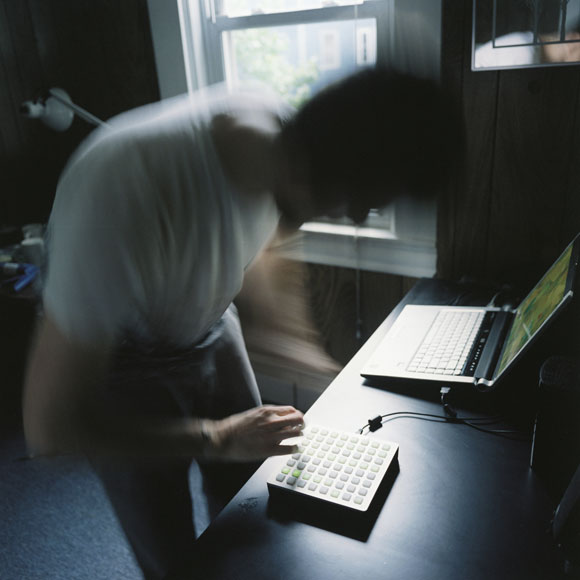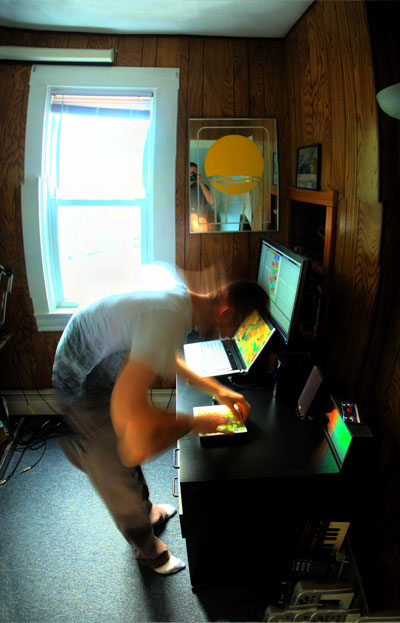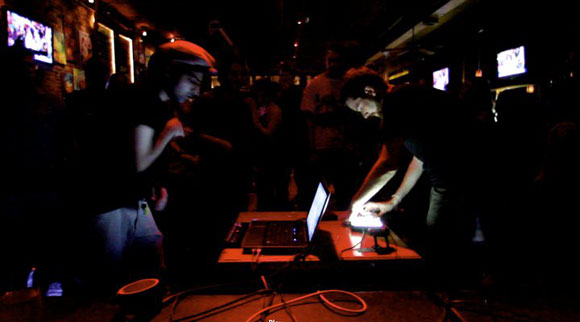
Artists and engineers, coders and musicians – maybe once these were perceived as separate cultures, but today, you can find people tap-dancing across the categories with ease – people like Adam. Adam Ribaudo, aka makingthenoise, is known in the monome community as the creator of SevenUp, an Ableton Live and Max for Live construction that is so named for combining seven functions. It is Navigation, Stepper, Sequencer, Controller, Looper, Loop Recorder, Melodizers, Clip Launcher, and Masterizer.
But Adam is also a force in live shows, someone who can put archaic Max contraptions or giant touchscreen virtual monomes to use and get people dancing.
The Boston-based artist is set to be part of the In/Out Festival this weekend. And he has a new album, “you can do anything. except for some things.” You can check out the album below or on Bandcamp, and it’s the subject of his chat with us.
CDM: How does the monome fit into your workflow (if at all) on this record?
Adam: It fits in heavily for the sample creation part of the process, but not necessarily the composition and arrangement. My workflow typically involves jamming on the monome for hours at a time and recording each sound source independently so I can steal snippets from here and there to piece into a cohesive whole.
Are you using any of your own custom software in this work, after the stuff you’ve made?
SevenUp Live makes an appearance in a number of tracks including “more buttons, no problems” which is done entirely with some kalimba samples on the “Looper” page. [Ed.: See its use live in the video below, from New York’s Coco66. -PK]

How do you think about rhythm here, or what has influenced your groove specifically (in terms of artists, etc.)?
I’m a beat junkie. My first love is creating new beats, shifting around the BPM, and seeing what they line up with. It’s a very mathematical and repeatable process while the melodies are sometimes a chore for me. I have yet to build a consistently good workflow for melody but maybe that’s a good way to keep things fresh.
Being my first album, I wanted the sound to be uniquely my own. I can’t say I was consciously invoking any single artist’s style but I can say I was listening to Toro y Moi’s album a lot around that time.
mtn – grind yer feet – live @ coco66 nyc 1-27-2010 from makingthenoise on Vimeo.
Obviously, you get a ton of energy out of your live shows. Has that had an impact on the way these songs are constructed?
Yessss. And no. Here we go. Performing live has been a hugely influential thing for me in terms of putting myself out there and getting real-time feedback from humans. It’s been amazing, it’s altered my workflow, and it’s changed the type of music that I’ve made for those purposes. BUT. … this album was an attempt to break out of the cycle of making songs that would perform well on stage and go back to my roots as a bedroom musician. That being said, the title track “you can do anything. except for some things” is taken directly from my live set and negates everything I just said. Live with it.
There are some great harmonic ideas in here; can you talk at all about how your harmonic conception evolves?
Lots of doubling and halving of tempos.
Can you reveal some of the sound sources here? There are some really gorgeous timbres, in particular some of the synths and pads. How do you orchestrate your tracks; how much is programming, or where do you look for sources?
80% of the melodies were either produced with one of the many community-created generators within Jeskola Buzz or by the wonderful free VST Oatmeal. Oh, and that’s Edison playing his Rhodes on the title track “you can do anything. except for some things”.
What’s your hardware and software rig for production here, both the sources and the final mix? What are you mixing with? (Obviously some liberal sidechaining in there, too…)
PC! It was all arranged and mastered right in Ableton, but the sound sources come from all over. The album is very old and new at the same time. It was entirely composed and arranged between January – April of 2010, but some of the individual sound samples and snippets date back years.
With the side-chaining, my aim was to use it more as a compositional tool than as a way to eek out a few more decibels here and there. Sometimes it’s faked by dropping the volume of one track right as another comes in. That being said, I promise to use less side chaining next time. Everyone gets one.

Ha – that’s okay! Keep it pumping. There are a number of found sounds and narrative elements that make their way into the mix, of course. What’s the significance of this choice for you?
Yes, yes, yes. For me, it’s such a sensitive decision when I’m about to include a sample generated by someone else. Am I altering the sample, or the context of the sample, to enough of a degree to maintain a certain level of originality? Or am I just being lazy?
The first track is littered with them, including a sample from an unreleased remix I did for Thomas Piper and a speech given to a high school by a guy who calls himself the “well-rounded square”.
The album: http://www.makingthenoise.com/anything/
Software and music: http://www.makingthenoise.com/
mtn – morning light from makingthenoise on Vimeo.